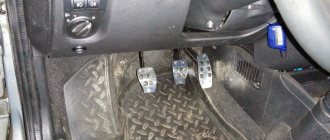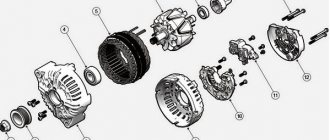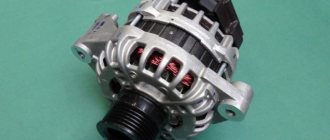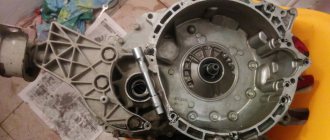All cars whose engines are cooled by a special liquid have at their disposal a device called a thermostat. Lada Granta is no exception.
In the Grant model, the thermostat is located between the radiator and the engine. In the article we will talk about the concept of a car thermostat, what components it consists of and how it functions, and also consider the main types of thermostat malfunctions.
The thermostat is called the antifreeze (antifreeze) temperature regulator in the engine cooling system. It increases the engine warm-up rate and maintains the required thermal state.
The key job of the thermostat is to hold back the flow of radiator fluid until the engine has warmed up. If the engine remains cold, the coolant does not pass through it to the radiator.
The thermostat opens when the engine temperature reaches 95 degrees. Thanks to its operation, the engine warms up faster. Thus, in the Lada Granta, the thermostat reduces the amount of harmful emissions and reduces engine wear to a minimum.
If desired, you can clearly see the operation of the thermostat at home. Place the thermostat in a container filled with water, then place it on the electric stove. As the moment of boiling water approaches, the thermostat valve will open approximately 2 cm. It is recommended to experiment with a new thermostat without removing yours from your own car.
Tips from experts on replacing the thermostat on your own on a Lada Grant (16 valves)
The thermostat is designed to redirect the flow of antifreeze when the engine reaches a certain temperature.
The design of the regulator is such that from the moment the engine is started until it warms up to 90°C, the antifreeze circulates through a small circuit. After 90°C, the thermostat opens the valve and redirects the antifreeze in a large circle through the system radiator to release excess heat.
Appearance of the new spare part
During operation, various malfunctions and breakdowns occur due to defects, deposits, and rust. Like any other unit, the regulator requires constant preventative maintenance and diagnostics.
Let's look at how to service the thermostat yourself using the example of a Lada Granta car.
About structural features and working conditions
Replacing the thermostat on a VAZ 2109
The materials from which manufacturers create thermostats include copper and brass alloys. The essence of the action of this product is contained in a small cylinder, which is turned towards the Lada Granta engine block. In the middle of this cylinder there is a wax ball, capable of starting to melt when the temperature in the cooling circuit reaches 82 degrees. The designers also integrated a special pin into the cylinder, which has a direct connection with the valve. As the wax melts, the substance expands, causing the pin to begin to be squeezed out of the cylinder. This action of this pin causes the valve to open, allowing the fluid to reroute. When the motor stops, the wax becomes solid, causing the designated valve to close.
Sequence of actions when replacing a thermostat on a Lada Grant (16 valves)
- We secure the vehicle within the perimeter of the repair area, provide priority safety measures, and install wheel chocks.
- We dismantle the oil pan protection.
- Drain the antifreeze.
- Disconnect the cooling system pipes.
- We unscrew the bolts securing the thermostat to the cylinder block and remove it.
- We inspect and replace worn elements.
- We assemble the mechanism in reverse order.
Thermostat appearance
Where is the thermostat located on the Lada Granta
In Lada Granta cars, the fluid flow distributor is located on the rear side of the cylinder block on the right side of the engine compartment.
In the operating manual, the thermostat is located on the section of the line between the radiator and the cylinder block.
The small circle consists of a jacket, a pump, and a stove heater. The large circle has a similar design, plus a radiator for the cooling system.
Note to the driver! In the Lada Granta modifications (16 valves), as well as in the 8-valve version, the heater is looped into a small circle. In previous VAZ models, the circuit was parallel.
Following these operating instructions, the regulator should be activated already at 90°C. The actual range is 78 - 93°C.
Preparing for replacement
There are no negative consequences from premature transition to open mode. As side effects we highlight:
- excess fuel consumption;
- formation of more carbon deposits in the chamber;
- incomplete combustion of the fuel mixture in the cylinder cavity;
- Excessive amount of smoke from the exhaust system.
Replacing the thermostat VAZ-2107
First, the antifreeze is drained from the cooled engine. Using a slotted screwdriver with a thin blade or pliers, loosen the clamp securing the hose supplying antifreeze from the radiator to the thermostat pipe. Disconnect this hose.
Use a Phillips screwdriver or an 8 mm socket wrench to loosen the clamps securing the hoses to the pipes of the cylinder block and pump. Remove the thermostat along with the hoses.
Disconnect the hoses from the thermostat pipes and put them on the new thermostat. Instead of the tape clamps that were on the hoses, they put on worm-drive clamps without tightening them.
The lower pipe of the thermostat is connected to the hose from the radiator. Connect the remaining hoses. All clamps are tightened. Fill in coolant. Start the engine and check for antifreeze leaks and the operation of the new thermostat.
Home →
Device → Cooling, heating and ventilation system → Thermostat →
Signs that you need to replace the thermostat on a Lada Granta (16 valves)
- after the engine warms up above 85°C, the pipes of the large circulation circle remain cold;
- antifreeze circulation occurs in jerks, which indicates incomplete opening/closing of the valve, the presence of rust layers;
- liquid leakage, depressurization;
- third-party mechanical damage, body deformation, cracks.
Required parts for installation
Features of the Lada Granta version with air conditioning
There are no differences in the design of the thermostat in the version of the Lada Granta with air conditioning. The only difference is the method of fixing the stove heater.
Sequencing
- We place the car on a platform with a slight slope back.
- We unscrew the 8 bolts around the perimeter of the oil pan protection and dismantle it.
- We unscrew the expansion tank cap and remove the vacuum.
- We unscrew the drain plug and grind the antifreeze waste into the container. Total 2.7 - 3.0 liters. Provided the consistency is clean, it can be reused.
We grind the waste into the container - Loosen the clamps and remove the two rubber pipes from the regulator fittings.
Two rubber pipes - Disconnect the negative terminal and unscrew the two nuts securing the regulator body to the cylinder block.
- Unscrew the screws of the cover and remove it.
- Using pliers, we recess the metal spring and remove the plate - valve from the regulator cavity.
- We carry out troubleshooting of elements and assess their condition. We replace worn out elements with new ones.
- We assemble the cooling system mechanism in reverse order. We first apply sealant to the flanges to prevent liquid leakage.
Note to the driver! You can check the serviceability of the old thermostat in the following way: put it in a container of water and heat it over low heat. When 85 - 90°C is reached, the rod should move upward, simulating the opening of the valve.
Checking at home
Sometimes the electric motor turns on too late, when the antifreeze temperature is already high. This may be caused by a malfunction of the valve in the radiator cap or abnormal parameters of the switch on sensor. You can check the device’s response temperature at home using a multimeter and thermometer.
After disconnecting the electrical connector, the sensor is unscrewed with a key. To avoid burns, remove the device only from a cold engine, after draining the antifreeze. When reinstalling, it is advisable to use a new sealing copper washer and not apply too much force when tightening.
The switching temperature is engraved on the end; it can be from 92 to 95 degrees. To check, you need to connect the multimeter in resistance measurement mode and immerse the threaded part in a container of water.
While heating the water and monitoring the readings of the multimeter, we use a thermometer to record the moment it turns on, and when it cools down, the temperature it turns off. Standardly, these are 92 and 87 degrees; with significant deviations, late operation is especially critical, the device requires replacement.
To improve cooling, it is possible to install a double fan from Niva. There are two modifications for placement: after the radiator or in front of it.
On the VAZ 2110, any of the options can be installed with minimal modifications to the fasteners on site. When electric motors are connected in parallel, the current consumption increases to 40 amperes, which requires replacement of the wiring.
Monitor the engine temperature. If you notice overheating too late, then in addition to boiling of the antifreeze and a forced stop, more serious consequences are possible: deformation of the cylinder head, jamming of the camshaft. If there are defects in the operation of the cooling system fan of the VAZ 2110, the faults can be diagnosed independently by checking the thermostat, electric motor, relay, and switch sensor.
Sources
- https://aveni-r.ru/datchik-temperatury-vaz-21083-skhema.html
- https://vazweb.ru/desyatka/ohlazhdenie/datchik-vklyucheniya-ventilyatora.html
Reviews
| № | Positive |
| 1. | Kirill: I’ve been actively using the car for a year, no comments, the cooling system works efficiently. In the summer I added 100 - 150 ml a couple of times. antifreeze, but this is typical at high temperatures. |
| 2. | Ignat: there are no problems with the heating system, the circulation is natural. At 30,000 km I replaced the “factory” antifreeze with imported one. |
| 3. | Vyacheslav: I recently carried out a scheduled technical inspection, according to the results of which the car is in good condition. There are no complaints about the heating system. |
| 4. | Valery: The car is already two years old, during this period there have been no major breakdowns. I eliminated the unimportant ones on my own. Domestic transport is still far from perfect. |
| 5. | Vladimir: I’ve heard criticism of the Lada Grant’s cooling system, but I can’t confirm it. From the first days after purchase, I take care of it, buy original parts, and visit service stations for diagnostics. |
| 6. | Ivan: at 50,000 km the rubber pipe on the antifreeze supply burst, replaced it myself. There were no more breakdowns, the thermostat is working normally. |
| 7. | Kirill: I replaced the regulator for the first time at 90,000 km, I think that the mileage is more than for domestic vehicles. |
| Negative | |
| 1. | Dmitry: in the first year after purchase, the car began to fall apart, I already visited the service station twice unscheduled, carried out diagnostics, and eliminated defects. |
| 2. | Zhora: I cannot recommend the Lada Granta for purchase, as there are many shortcomings that are not corrected by the manufacturer. |
| 3. | Peter: the model has many shortcomings, it’s a pity that the manufacturer does not eliminate them in new versions of the Lada. |
Conclusion
The cooling systems of the 8-valve and 16-valve modifications of the Lada Granta are in many ways similar to each other. The mounting location of the thermostat is identical, the supply diagram for the supply and antifreeze return pipes is similar.
The difference is that in the 16-valve version it is necessary to remove the oil pan protection to drain the waste. In the younger modification, it is enough to disconnect several pipes at the location of the distributor in the engine compartment.
Source
Grant's thermostat
Introduction
Any car has an engine cooling system, which must maintain the operating temperature of the engine. The main element responsible for the stable temperature of the coolant is the thermostat; it regulates when to pass coolant through the cooling radiator and when to bypass it.
When this element fails, the car engine begins to operate in incorrect temperature conditions, which can lead to its breakdown.
In this article we will talk about the thermostat on a Lada Granta car, signs of its malfunction, methods of checking and replacing it yourself.
How to tell if the thermostat is working correctly
In order to find out whether the thermostat is working or not, it is necessary to warm up the engine so that the arrow indicating the temperature does not reach the red mark of the indicator quite a bit.
After that, turn off the engine, go to the hood and open it, look for the upper radiator hose. This rubber hose is usually black in color and is approximately 5cm in diameter.
There are metal clamps at its ends. The upper hose is attached to the top of the radiator. Then we look for the lower hose. It looks like the top one, only it is attached to the bottom of the radiator.
Touch the hoses carefully; they may be hot enough to burn you. If the engine temperature indicator shows that the engine is hot, but one of the hoses is cold, then most likely the thermostat valve is closed and is not allowing coolant through the radiator.
In this case, replace the old thermostat with a new one as quickly as possible (after waiting until the engine has cooled down).
There is another “folk” method for checking the functionality of the thermostat and it is as follows. Place the thermostat in a vessel with boiled (temperature should be about 100 degrees) water.
Next, we visually observe whether the thermostat valve opens. If it opens, it means it’s working. If not, we replace the damaged one with a new one. The above method involves removing the thermostat from the car.
If the thermostat malfunctions in a car, overheating or, more often, low engine temperature is observed. Such phenomena are associated with the thermostat jamming in one position; as a result, the coolant moves in one circle (large or small). Lack of adjustment of coolant distribution leads to deviations from the engine temperature regime. Thermostat failure is one of the most common problems in a cooling system. To replace the thermostat on a Lada Granta car, the coolant from the cooling system does not need to be completely drained.
You will need: TORX TZO wrench, 13mm socket, Phillips-blade screwdriver.
Basic thermostat malfunctions
The thermostat is a small, but no less important component of the car. A malfunctioning thermostat will most likely strand you on the side of the road. There are many reasons why a thermostat fails, but the most popular reason is corrosion.
If the thermostat is stuck and is in the completely closed position, the engine will most likely overheat, regardless of the driving mode and ambient air temperature.
If the thermostat is in the open position, but not all the way, the motor will overheat, but there is a possibility that it will not “boil”. Whether this happens or not depends on how the car is used.
If the thermostat valve is held in a completely or partially open position, it will take a very long time for the engine to warm up to the required operating temperature; in winter, the engine may not reach such a temperature.
With a working cooling system at a temperature of zero degrees, the engine warm-up time should take up to 10 minutes. In case of defective opening, the engine temperature will not rise above 70 degrees even in summer.
In both of these cases, it is necessary to replace the thermostat on the Grant or any other car. Next, let's look at how to check whether our thermostat is functioning.
Self-conversion of the Lada Granta thermostat to 92 degrees
As you know, modern cars use a special liquid to cool the power plant. The versatility of this option allows you to simultaneously provide interior heating in winter. In order for this system to work properly, a special device called a thermostat is also installed in it. In another way, it is also called a coolant temperature regulator. One of its functions is to help the engine warm up as quickly as possible and maintain it in the required condition.
Removing and checking the Lada Granta thermostat
Tools:
- Medium Phillips screwdriver
- 10 mm open-end wrench (for 16-valve engines)
- 13 mm straight box spanner (for 16-valve engines)
- Ratchet wrench
- Extension
- 8 mm head
- 10 mm head
- 13 mm head
- Torx T30 socket
- Funnel
- Pliers
Parts and consumables:
- Coolant 8 l
- Technical capacity
- Vessel
- Thermometer
- Sandpaper (fine grit)
- Rags
- Thermostat bottle (replacement if necessary)
- Thermostat cover o-ring
- Gasket at the connection between the thermostat housing and the cylinder head
If the thermostat is working properly, after starting a cold engine, the lower hose leading away from the radiator should remain cold for some time, and then (after the coolant temperature exceeds 85±2°C) quickly heat up, which indicates the start of coolant circulation in a large circle.
1. To remove the thermostat, remove the air supply hose to the throttle body and the air filter.
2. Drain the cooling system as described here (for 8-valve engines) or here (for 16-valve engines).
3. After releasing the engine management system wiring harness connector, disconnect the connector from the coolant temperature sensor connector as described here.
Signs of breakdown
The thermostat is a fairly simple element, however, and it is not immune to breakdowns. Normally, after starting a cold engine, the lower hose extending from the radiator does not heat up for some time, but after the coolant temperature exceeds 85C (±2C), it begins to quickly heat up (provided the thermostat is in full working order). It is this aspect that will accurately indicate to the car owner the moment the coolant begins to circulate.
In cases where the valve cannot open, the coolant stops circulating and the engine begins to overheat. Overheating also causes incomplete opening of the valve. A delay in closing the valve, on the contrary, creates conditions for a longer warm-up of the engine, especially in the cold season.
As a rule, thermostat failure is caused by the following reasons:
- an unstable engine (triplication often leads to valve damage);
- wear of the rubber gasket;
- corrosion (it is the most common cause of breakdowns);
- antifreeze gets inside the thermostat;
- there is a leakage of wax from the device;
- there is mechanical damage on the valve.
Most often, a malfunction of the thermostat leads to the impossibility of further movement in the car, and therefore the faulty part must be replaced immediately.
How to replace a LADA “Granta” thermostat with 8 and 16 valves
The Granta thermostat is a key part of the engine cooling system. ensuring the optimal temperature of the coolant and the power unit itself. Thermostat malfunctions can lead to overheating and breakdown of the car engine, so it is advisable for owners to know how to check and replace the LADA Granta thermostat.
Features of the LADA Granta cooling system
As in previous LADA models, upon reaching a certain temperature, the thermostat switches the coolant flow from a small to a large circuit. The small circuit includes:
- cylinder water jacket;
- water pump;
- interior heater.
The difference is that the heater radiator is connected to a small circuit in series and not in parallel. This forces all the coolant to pass through it, improving the heating of the cabin. The thermostat opening temperature is 85 degrees. Upon reaching this mark, the valve opens and the liquid begins to circulate through a large circuit into which.
In addition to the small circuit elements, a cooling radiator is included. The advantage of the modernized cooling system is that antifreeze from the engine jacket falls directly onto the thermostat thermocouple without mixing in its housing. This allows the element to respond to the actual engine temperature, opening on time and preventing overheating.
The manufacturer has set the permissible thermostat opening range to 85–7 degrees. That is, it can open at both 78 and 93 degrees. According to the official letter from the manufacturer, sent to dealers, the operating temperature of the Grant engine may be 10 degrees lower than that of previous VAZ models. This does not mean that the engine is “underheated” and does not lead to an increase in fuel consumption, deterioration of lubrication and a decrease in engine life. However, owners of the LADA Grant often change the thermostat to a new one, with an opening temperature closer to 90 degrees, or modify the standard thermostat by changing the thermal element.
When is it necessary to replace the LADA Granta thermostat?
The thermostat should be changed if it does not close a large circuit even when the engine is hot or opens at temperatures above 92 degrees. In the first case, the engine does not warm up enough, which impairs the combustion of the air-fuel mixture and the circulation of oil through the oil channels. When opening late, at best, the cooling fan often turns on; at worst, the crankshaft bearings fail or the engine head becomes deformed, which requires complex, expensive repairs. The design of the LADA Granta thermostat does not provide for its repair, so the failed part must be replaced with a new one.
You can verify that the thermostat is working without removing it from the car by feeling the temperature of the pipes of the large cooling circuit or the bottom of the radiator. They should be cold until the engine reaches operating temperature. After the engine warms up, the thermostat opens and the elements of the large circuit should heat up.
How to change the thermostat of LADA “Granta”
The LADA Granta is equipped with power units with 6 and 8 timing valves. The location of the thermostat in these models is different, and accordingly, the replacement procedure is also different.
To replace the thermostat on the eight-valve Granta version you need:
- Phillips screwdriver;
- socket wrenches for 10 and 13;
- crosshead screwdriver;
- key T30;
- container for coolant.
Replacing the LADA Granta thermostat (8 valve) is performed as follows:
- install the LADA Granta on a site that has a slope so that the front part is higher than the rear;
- unscrew the bolts securing the engine protection and remove it;
- place a container for coolant under the radiator;
- remove the cap covering the expansion tank;
- Unscrew the drain plug on the radiator;
- drain the coolant into a container;
- tighten the drain plug on the radiator;
- press the latch and disconnect the wiring block from the coolant temperature sensor;
- loosen the clamp securing the rear hose to the thermostat cover pipe;
- remove the hose from the pipe;
- loosen the clamp securing the front hose to the thermostat cover pipe;
- remove the front hose from the pipe;
- unscrew the nut holding the ground wire to the thermostat mounting stud;
- remove the washer and the ground wire tip from the stud;
- unscrew the two nuts securing the thermostat to the engine, remove and set aside the washers;
- pull the thermostat housing off the studs;
- remove the thermostat gasket;
Important: when removing or replacing the thermostat, the sealing gasket must be replaced with a new one!
- unscrew the three bolts holding the thermostat cover;
- remove the cover;
- press out the thermostat fixing plate, overcoming the resistance of the spring;
- turn the plate, remove it from the grooves and pull it out;
- remove the spring;
- pull the thermostat out of the housing.
The new thermostat is installed in the housing in place of the old one; further operations should be performed in the reverse order of removing the part.
Tip: before installing the hoses on the pipes, you should lubricate the latter with a thin layer of sealant, this will prevent possible leakage of coolant.
After installing the thermostat, it is necessary to fill the cooling system with antifreeze (coolant), start and warm up the engine, making sure that air pockets are removed from the cooling circuits.
To replace the thermostat on the sixteen-valve Granta version, you will need:
- crosshead screwdriver;
- key to 10;
- hex key 5;
- container for coolant.
The car must be placed on a level area, preferably with a slight slope, so that the front part is raised relative to the rear. Before replacing the thermostat, drain the coolant from the system. To do this, you need to remove the engine protection, open the expansion tank cap, place a container for coolant under the radiator and drain the latter by unscrewing the radiator drain plug. After the liquid has been drained, you can tighten the drain plug and begin replacing the thermostat. Removing the LADA “Granta” thermostat (16 valves) is performed as follows:
- loosen the clamps of the hoses supplying coolant to the thermostat cover;
- disconnect the hoses from the thermostat cover;
- Unscrew the bolts securing the thermostat cover;
- remove the thermostat cover from its seat;
- remove the sealing ring from the groove in the thermostat cover (it must be replaced with a new one);
- push down and rotate the plate that secures the thermostat in the lid;
- remove the plate and thermostat from the cover.
Revision option
As evidenced by reviews from grant owners, the manufacturer supplies this model with a rather weak thermostat. Usually it opens access to antifreeze after the engine warms up to 80 radii. This is due to low-quality wax inserts, which we described above.
In most cases, such a problem is not perceived as something serious, since it does not harm the operation of the engine in any way. The only drawback is that in winter, when there is frost, the interior can be cool. The situation becomes more complicated if the owner of the car switches to gas.
In this case, it makes sense to modify the thermostat so that it opens at 92 degrees. To do this you will need to purchase a new one. The entire element does not need to be replaced, so only the insert is taken out of the purchased one.
Experts advise choosing the model – VERNET TH4898.92D. Its cost is low - approximately 400 rubles.
The step-by-step replacement procedure is as follows:
- first of all, the car is driven onto a ramp or pit;
- drain antifreeze from the cooling system;
- remove the air duct because it is in the way;
- the thermostat itself is dismantled (but you can leave it in place and only remove the cover from it, the main thing is not to lose the seal);
- the old thermocouple is removed and a new one is inserted;
- they press it with the original spring and limiter.
On average, the response temperature after such a procedure increases by 15 percent.
The whole process is recorded in this video:
All cars whose engines are cooled by a special liquid have at their disposal a device called a thermostat. Lada Granta is no exception.
In the Grant model, the thermostat is located between the radiator and the engine. In the article we will talk about the concept of a car thermostat, what components it consists of and how it functions, and also consider the main types of thermostat malfunctions.
The thermostat is called the antifreeze (antifreeze) temperature regulator in the engine cooling system. It increases the engine warm-up rate and maintains the required thermal state.
The key job of the thermostat is to hold back the flow of radiator fluid until the engine has warmed up. If the engine remains cold, the coolant does not pass through it to the radiator.
The thermostat opens when the engine temperature reaches 95 degrees. Thanks to its operation, the engine warms up faster. Thus, in the Lada Granta, the thermostat reduces the amount of harmful emissions and reduces engine wear to a minimum.
If desired, you can clearly see the operation of the thermostat at home. Place the thermostat in a container filled with water, then place it on the electric stove. As the moment of boiling water approaches, the thermostat valve will open approximately 2 cm. It is recommended to experiment with a new thermostat without removing yours from your own car.
At what temperature does the thermostat on the Lada Granta open?
Car : Lada Granta. Asks : Shmakov Viktor. The essence of the question : At what temperature does the thermostat on the Lada Granta open?
Please tell me at what temperature the thermostat on the Lada Granta should open, with the settings that were installed on it from the factory?
| TOP 15 most useful products for Lada Granta - OUR EXPERIENCE! |
- 1 Opening and closing temperatures of the thermostat on Grant 1.1 Video review of the factory thermostat
- 2 What is a thermostat (functions, principle of operation)
Thermostat opening and closing temperatures on Grant
The thermostat has two valves: main and additional. At a fluid temperature of up to 85 °C , the thermostat is tightly closed, and it circulates in a small circle, bypassing the radiator, which helps to warm up the engine as quickly as possible. As soon as the temperature rises from 86° C , the thermostat begins to gradually open and at a coolant temperature of 102° C , it opens completely, ensuring its passage in a full circle through the radiator.
Thus, it becomes clear that the thermostat starts working already from 86 °C.
Video review of the factory thermostat
What is a thermostat (functions, operating principle)
Thermostat location under the hood
The thermostat, equipped with a solid heat-sensitive filler installed on Lada Granta cars, is designed to maintain the optimal operating temperature of the engine coolant, as well as to reduce its warm-up time.
Carrying out an inspection
The process of checking the thermostat is a relatively simple procedure. To begin, the removed thermostat bottle is lowered into a transparent container into which coolant has previously been poured. Next, this container is heated, periodically stirring the coolant and monitoring with a thermometer the moment when the cylinder rod begins to move. When the coolant reaches a temperature of 85C (±2C), the rod of a fully working device will begin to extend. When the liquid in the container is heated to 100C (±2C), it will extend completely.
Lada Granta thermostat replacement
On grants with engines 11183 and 11186 (21116), 21126, a BEHR thermostat is used.
1 – body; 2 – sealing ring; 3 – balloon; 4 – spring; 5 – fixing plate; 6 – cover
The thermostat consists of a metal cylinder with a heat-sensitive filler, a spring and its fixing plate. The cylinder rod fits into the socket of the thermostat housing. In the closed position of the thermostat (on a cold engine), its spring, resting on the fixing plate, presses the cylinder plate to the seat of the hole in the housing, closing the channel between the housing and the thermostat cover. As a result, the flow of coolant through the radiator of the cooling system is blocked. In this case, all the liquid circulates through a small circle of the cooling system: pump, cooling jackets of the cylinder block and cylinder head, thermostat housing and cover, heater radiator, steam exhaust hose of the cooling system radiator, expansion tank, pump supply pipe. When the coolant temperature reaches (85±2) °C, the thermostat bottle filler begins to melt and increases its volume, pushing the rod out of the thermostat bottle. In this case, the cylinder plate moves away from the seat, and the liquid begins to circulate in a large circle, which includes the pump, cooling jackets of the cylinder block and cylinder head, thermostat housing and cover, radiator of the cooling system, steam exhaust hose of the radiator of the cooling system, expansion tank, heater radiator, pump supply pipe. When the coolant reaches a temperature of (100±2) °C, the thermostat valve opens completely.
Coolant temperature sensor
The coolant temperature sensor installed in the thermostat cover provides information to the engine management system controller
Differences in thermostat design.
The design of the thermostat uses a valve of a different design in contrast to valve 21082. The valve disc has an outer diameter of 29 mm, and valve 21082 has a disc diameter of 32 mm. Replacing one valve with another is possible thanks to a recess in the thermostat housing for valve 21082. If you install valve 21082, it is better to rub the seat with valve grinding paste. The rubber-coated valve Luzar 21082 does not require lapping. For those who like temperatures of 90-92 degrees, thermoelement TN 4898.92(J) It also needs to be removed from the body and rubbed in with lapping paste for 5-10 minutes (preferably). The best option for replacing the original thermoelement would be WAHLER 3091.92D. it has one bore diameter, but is rubberized and does not require lapping.
general information
Replacing the thermostat on a VAZ 2112 16 valves
There are single-valve, two-stage and two-valve thermostats, as well as electronically controlled devices. Grants are equipped with thermostats Luzar LT0191 and Luzar LT0190 (costing from 450 rubles for the first, and from 800 rubles for the second), FENOX TS034E7 (costing from 800 rubles), VAZ-2123 (article 2123-1306010, cost from 650 rub.). It is worth mentioning such devices as VAZ-2101 GATES (article TH14580, cost - from 350 rubles), VAZ-2121 GATES (article TH15380, approximate cost - from 500 rubles), VAZ-2110 (article 21082-1306010, cost - from 600 rub.) and other devices. They are located between the engine and the radiator, but it should be noted that there are differences in the location of the thermostats on Grants with eight-valve and sixteen-valve engines.
Their main task is to prevent the movement of antifreeze through the radiator until the car engine warms up to the required temperatures. Accordingly, if the car engine does not warm up, then the coolant does not move in a large circle. Usually the thermostat is activated when the engine reaches a temperature of 80-95C. Among other things, the thermostat helps reduce the amount of harmful emissions released into the atmosphere and minimize engine wear.
The thermoelement located inside the device is made of brass, has a cylindrical shape and is filled with artificial wax. When the engine reaches a temperature of approximately 82C, this substance begins to melt, which causes it to expand. This sets the valve in motion, it opens, after which the antifreeze begins to circulate through the car’s radiator. Turning off the motor causes the wax to solidify inside the thermostat and close the damper.
Below we will talk in more detail about possible malfunctions of thermostats, provide instructions for replacing and checking them, and also share a technique for reworking and upgrading this part, allowing you to increase its response threshold to 92C.











